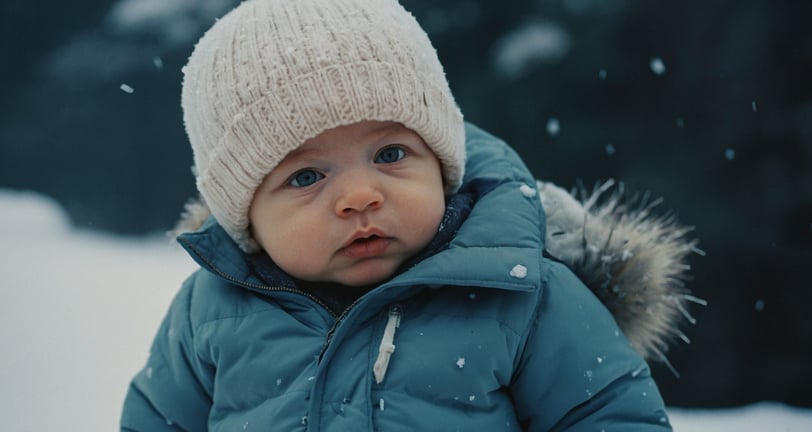Signs Your Newborn Is Too Cold
Keeping Your Baby Safe and Comfortable


As a new parent, one of your top priorities is keeping your newborn safe and comfortable. One of the significant challenges during the colder months is ensuring that your baby stays warm enough. Babies have a harder time regulating their body temperature, which can make them susceptible to feeling cold. This blog post will explore the signs that indicate your newborn may be too cold and offer tips on how to keep them warm.
Understanding Your Newborn's Temperature Regulation
Newborns have a limited ability to regulate their body temperature, making them more sensitive to cold. Their small body size, combined with a higher surface area-to-volume ratio, means they can lose heat quickly. It's crucial to understand how to recognize when your baby is feeling chilly to prevent any potential health risks.
Signs Your Newborn Is Too Cold
1. Cold Hands and Feet
One of the first signs that your newborn may be feeling cold is the temperature of their extremities. If your baby's hands and feet feel noticeably cold to the touch, it could be an indication that they are not warm enough. It's essential to remember that it's normal for a newborn's hands and feet to feel cooler than their core body temperature, but extreme coldness can be a cause for concern.
2. Chattering Teeth or Shivering
While shivering is a common way for adults to generate heat, newborns typically do not shiver in the same way. Instead, if you notice any muscle twitching or chattering of their teeth, this could indicate that your baby is too cold. This response is a sign that their body is trying to generate warmth.
3. Lethargy or Excessive Sleepiness
If your newborn seems unusually lethargic or sleeps more than usual, it might be a sign that they are too cold. When babies are chilly, they may conserve energy by becoming less active. Monitor their activity levels and seek to keep them warm if they appear more lethargic than normal.
4. Changes in Skin Color
Pay attention to your baby's skin color. If their skin appears pale, bluish, or mottled, this could indicate that they are cold. Healthy skin should be a warm, pinkish color. Any significant changes in skin tone should prompt you to check their temperature and warm them up.
5. Crying or Fussiness
A cold baby may express their discomfort through crying or fussiness. If your newborn seems unsettled or cries more than usual, it may be worth checking their clothing and the room temperature to see if they are too cold. A warm environment and proper clothing can help soothe a fussy baby.
6. Low Body Temperature
One of the most reliable ways to determine if your newborn is too cold is to check their body temperature. A normal body temperature for newborns is typically around 97.7°F to 100.4°F (36.5°C to 38°C). If you find that their temperature is below 97.7°F (36.5°C), it may indicate that your baby is too cold and requires immediate warmth.
Tips to Keep Your Newborn Warm
Knowing how to keep your baby warm is essential for their safety and comfort. Here are some tips to ensure that your newborn stays cozy during the colder months:
1. Dress in Layers
Dressing your newborn in layers is an effective way to regulate their body temperature. Start with a soft, snug onesie as a base layer. Then add a sleep sack or swaddle for additional warmth. Layers allow you to adjust clothing as needed, depending on the temperature.
2. Use a Hat
A significant amount of body heat can be lost through the head, so it's important to keep your baby's head warm. Consider using a soft hat made from breathable materials to trap heat while still allowing for air circulation.
3. Monitor Room Temperature
Keeping your baby's room at a comfortable temperature is essential. The ideal room temperature for a newborn is around 68°F to 72°F (20°C to 22°C). Use a room thermometer to monitor the temperature and adjust heating as needed.
4. Avoid Overheating
While it's important to keep your baby warm, be careful not to overheat them. Signs of overheating include sweating, flushed skin, and rapid breathing. Always dress your baby appropriately for the conditions, and remove layers if they appear too warm.
5. Provide Warm Bedding
Use warm, cozy blankets and bedding materials for your newborn’s crib or bassinet. However, avoid loose blankets that can pose a suffocation risk. Opt for sleep sacks or swaddles designed specifically for newborns to keep them warm without the risk.
6. Keep Baby Close
Skin-to-skin contact with your baby can help keep them warm. Holding your newborn close can provide them with extra warmth and comfort. Additionally, using a baby carrier can help maintain their body heat while keeping your hands free.
Recognizing the signs that your newborn may be too cold is crucial for their well-being. By paying attention to their body temperature and behaviors, you can ensure that your baby remains comfortable and safe during the winter months. Always remember to dress your newborn in layers, monitor room temperatures, and provide warm bedding. With these tips, you can create a cozy environment for your little one, allowing them to thrive even in the coldest weather. If you ever have concerns about your baby’s temperature or health, don’t hesitate to consult your pediatrician for guidance.
